News of implementing a decades-old plan, spark excitement and new hope for heritage-conscious Filipinos. The plan to rebuild the church of San Ignacio seems promising. Spearheaded by the Intramuros Administration under Bambi Harper, the project calls for reconstructing the church and turning it into an ecclesiastical museum as Museo de Intramuros.
Known as the Jesuit's Golden Dream, San Ignacio church was renowned for its graceful façade and an interior beautifully decorated and richly clad in tropical hardwoods. One of the last churches to be built on Intramuros, it replaced an older church, La Compañia, that formerly belonged to the Jesuits before their expulsion from the Philippines and other Spanish colonies in 1767.
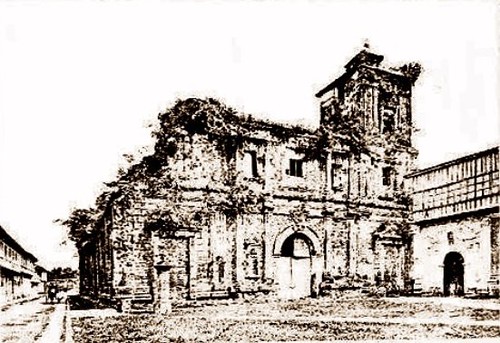
Ruins of La Compañia in Intramuros, Manila.
Built on Calle Arzobispo, San Ignacio church was designed by Filipino architect, Felix Roxas, whilst its interior was furnished by Isabelo Tampinco, Manuel Flores, Crispulo Hocson and other Filipino artisans. Agustin Saez, director of Escuela de Bellas Artes in Manila, contributed to the project by designing the retablos and pulpit.
The cornerstone of the church was laid on February 9, 1878 and was completed, inaugurated and consecrated 12 years after in July 27 - 30, 1889. (Reseña Histórica)
The church was a celebration of Philippine art. From its architect, to the artists that decorated it and to the materials it was made of, it was a treasure chest of everything Filipino.
San Ignacio was a source of pride for a country then beginning to develop a sense of patriotism. An obra maestra to the eyes of locals and foreigners, it was considered a must a see sight for any visitor in pre-war Manila, and even a popular wedding destination.
San Ignacio church met its demise during World War II. The war imposed its horrors to the country and San Ignacio was no exception. During the Battle for Manila in 1945, the church was razed by the Japanese.
Today a ruined shell, San Ignacio church awaits the time when it will arise from its slumber, so that once again, the Jesuits' Golden dream is a reality.
While we await for San Ignacio's eventual restoration to its former splendor, let's take a look back at its original form.
Let us start from the outside.
Filipino architect Félix Roxas who designed San Ignacio, opted for a façade done in the neoclassical style. (He had previously designed a Gothic church for Sto. Domingo in Intramuros, another beautiful church rich in history, grandeur and importance but also lost in WWII.)

The main element of the façade is the pediment. It is supported by four pairs of twin columns; the bottom columns are rendered in the Ionic order, while the top are in the Corinthian style. The use of twin columns in church facades has been described as distinctly Filipino.("The "City of God"")
Flanking the pediment are graceful, twin towers.
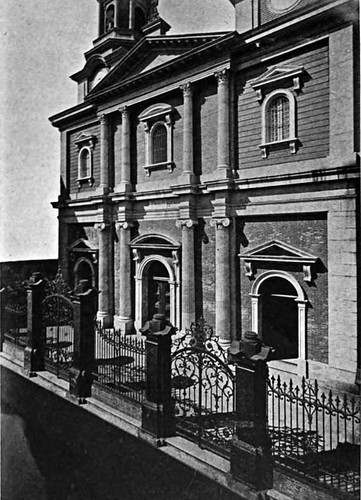
The walls separating the church compound from Calle Arzobispo are laced with wrought iron grilles and the posts are topped with ornate faroles.

Enter the church and the rows of arches and columns direct the faithful's gaze straight to the high altar, Retablo Mayor, designed by Agustin Saez.
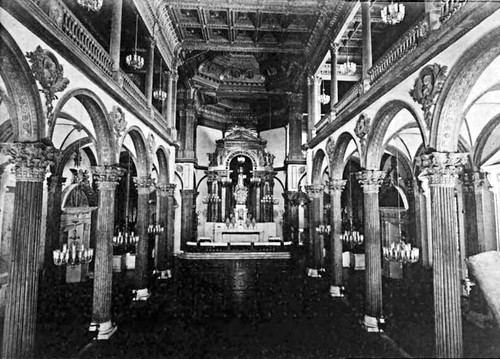
Where San Ignacio de Loyola is enshrined - the founder of Compañía de Jesú, the Jesuit order and the church's patron saint.

Here, a triumphant San Ignacio is exalted into heaven by angelic hosts. This is the Apotheosis of San Ignacio all rendered in wood by Manuel Flores, a noted Filipino sculptor.
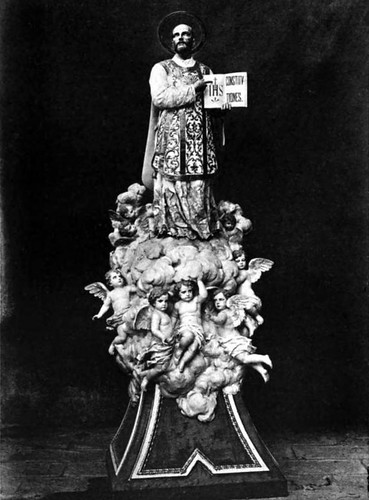
The tallado, carved, image of San Ignacio with an upturned gaze.

What might San Ignacio be staring at the ceiling? A vision of the Holy Spirit in a nimbus of glory captivates his ecstatic attention.
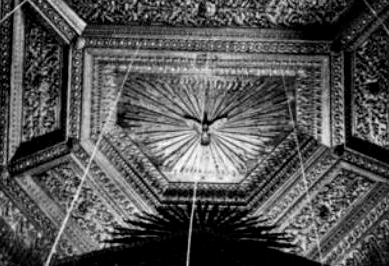
While the central apse above the Retablo Mayor is decorated with the Holy Spirit in the form of a dove, the adjacent crossing features a recessed, octagonal dome ornamented with medallions bearing the faces of Jesuit saints. ("The San Ignacio")
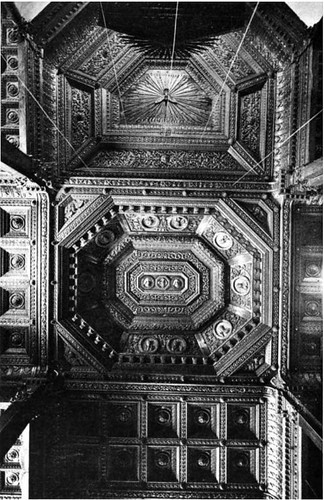
And radiating from the crossing, the church ceilings are coffered with exquisite panelings all rendered in wood.

The central nave boasts of larger panels,
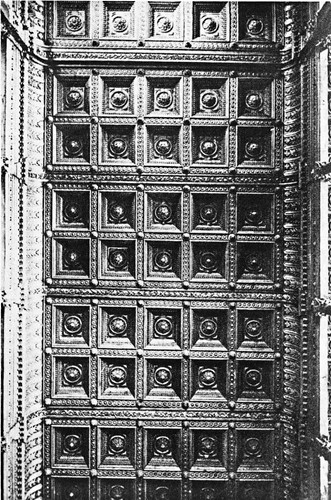
each decorated with medallions, florid forms and foliage.
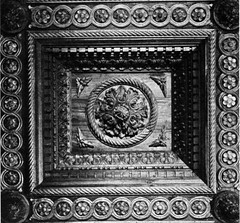
These exquisite artesonado ceilings are what made San Ignacio famous and much beloved. Isabelo Tampingco and his atelier rendered all of these in expensive Philippine hardwoods.
After craning our necks at the ceiling, we focus our eyes on the Retablo Menors and the doors nearby.
The Retablo Menors, side altars, are executed following Agustin Saez's plan ("The San Ignacio")and are dedicated to the Sagrado Corazon and Inmaculada Concepcion.
The altar to the Sagrado Corazon houses a Christ enveloped in a mandorla.
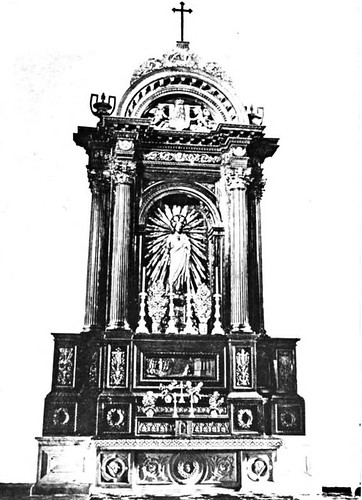
Manuel Flores shows Christ atop the world and with one hand pointing to his flaming heart, the other, outstretched to the the faithful.
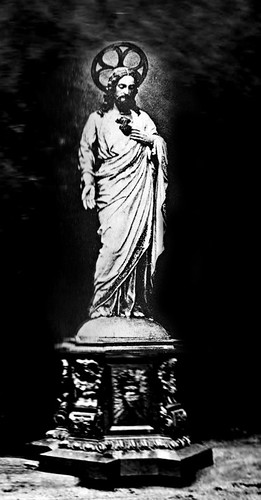
And with a slightly bowed head, expressing compassion to all humankind.
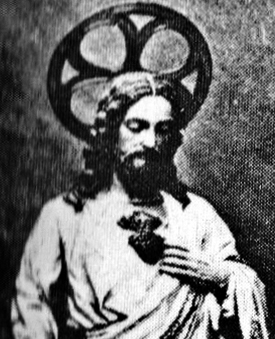
While the icon of Inmaculada Concepcion smiles demurely and with downcast eyes showing humility.
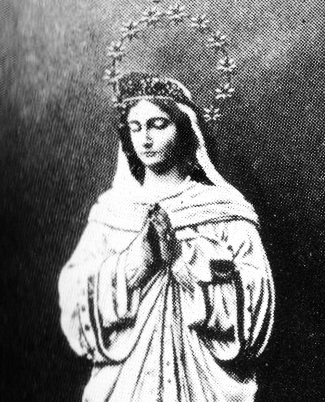
This sensitive image of the Blessed Virgin Mary is carved by Crispulo Hocson, Tampingco's father-in-law. Hocson sculpted the Virgin with her usual attributes, identifying her as the Virgin of the Apocalypse: a mandorla, a crown, twelve stars encircling her head and a crescent moon at her feet.
But in his tender rendering, Hocson managed to make true the Catholic doctrine of the Virgin's immaculate conception, which this statue represents. She stands on a globe and with one foot trampling the serpent of paradise with its forbidden fruit, symbolizing that she is free from fault- the Virgin Mary unblemished from the stain of original sin.

The Virgin is enshrined in a side altar identical to her Son's.
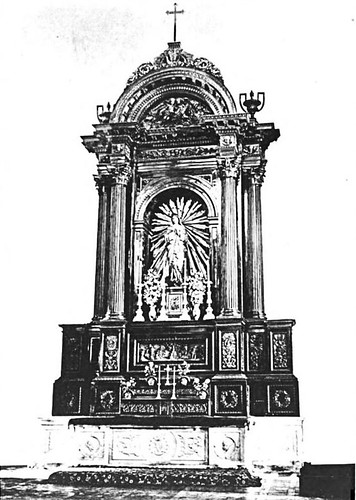
And the side door near her altar is capped with her monogram.

Another much celebrated feature of San Ignacio church is its pulpit.
Designed by Saez and carved by Tampingco, the pulpit is renowned for its exquisite details. (Miller)
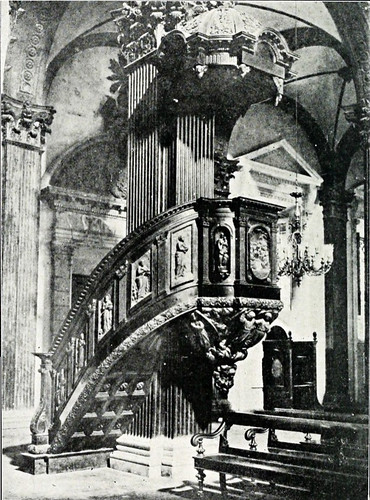
The stairs to the pulpit are covered with panels depicting the Four Evangelists: Sts. John, Matthew, Luke and Mark.
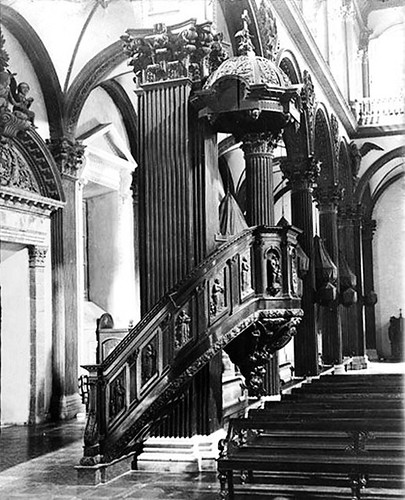
And the procession of the Evangelists leads to bas-reliefs showing the Descent of the Holy Spirit and Christ's Great Commission, where Christ instructed his disciples to baptize all nations under the Holy Trinity. The likeness of Faith, Hope, and Charity surround both scenes. ("The San Ignacio")
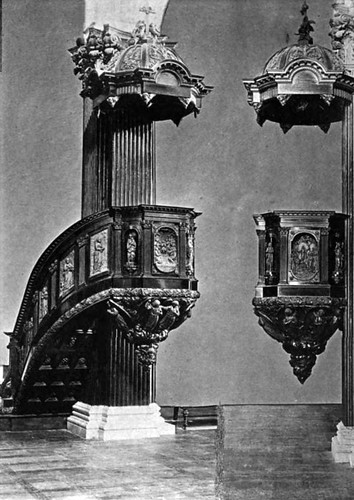
A group of angels struggle to support the entire pulpit.

From here, we say our goodbyes to San Ignacio and to his church and head for the door.
But before we do, let's send out a postcard to our friends, relatives and to ourselves in remembrance of this beautiful church.
Text, Victor Ancheta ©2009
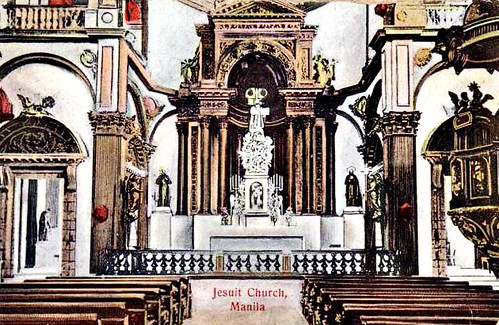
"The "City of God": Churches, Convents and Monasteries." Life's a Journey. N.p., n.d. Web. 22 June 2009.
Miller, George. Interesting Manila. 3rd ed. Manila: n.p., 1912). Interesting Manila. Web. 22 June 2009.
Reseña Histórica de la Inauguración de la Iglesia de San Ignacio de Loyola. Manila: Imprenta y Litografia de M. Perez, Hijo, 1890. University of Michigan, 17 Feb. 2006. Web. 22 June 2009.
"The San Ignacio." The Philippine Jesuits. N.p., n.d. Web. 22 June 2009.
.





10 comments:
Its nice to hear that they will be "recycling" the old church.
Huwaw!
Amazing, no?
Yes, all good news.
ang ganda! i cannot help but be sad over such a great splendor being lost... i do hope that the restoration efforts would truly be realized...
Nice article about the church. It is the best that I've researched about the church so far. ;D Thanks for posting this. ;D
It is currently under construction. Finally!!
Can you possibly update us about this sir?
se lo puedes agradecer al presidente de EEUU quie dio la orden para arrasar manila con bombas despues termiar con las excavadoras el trabajo !
The statues of the saints were they saved or were all lost??? If ever they were saved, where are they now???
They were sadly all lost. Only a part of the coffered ceiling remain, which is on display in Ateneo de Manila's Rizal Library. A friend of mine studied there in Ateneo, and many mistook it for an ornate door, as it was displayed against a wall. I'm not sure if they removed it or it is still there
Post a Comment